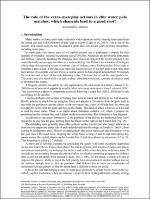Chapter The role of the extra-man play actions in elite water polo matches: which elements lead to a good shot?
Abstract
In water polo, two teams comprised of six outfield players and a goalkeeper compete for four quarters of 8 minutes’ real play in a playing area of 30x20m. Each team has 30 seconds to complete an action. A frequent situation thought to be very significant to the final result of a match is the extra-man play action. After a major foul a player is sent out of play for 20 seconds. The attacking team, with a series of passes and player movements must quickly try to disrupt the defence and enable a shot. And defence has to work on coordination of movement between players so that the attack finds it difficult to score too easily. Coaches dedicate a lot of time to training their team to attack and defend in an extra-man situation. This paper investigates the issue of extra-man play actions in detail. A study is performed into data from the 2020 European men’s water polo championships, whose aim is to identify whether man-up play actions have any elements that lead to a good shot, meaning a ball in the goal even if it is saved. Several characteristics were recorded on each extra-man play action, but only few of them seem to influence its outcome. This may be explained by the fact that the outcome of a play action is not only linked to the execution of a strategy, but it is influenced by factors which may not all be measured.
Keywords
water polo analytics; match analysis; tactical indicators; logistic regressionDOI
10.36253/978-88-5518-461-8.21ISBN
9788855184618, 9788855184618Publisher
Firenze University PressPublisher website
https://www.fupress.com/Publication date and place
Florence, 2021Series
Proceedings e report, 132Classification
Social research and statistics


 Download
Download Web Shop
Web Shop